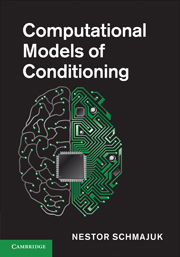Book contents
- Frontmatter
- Contents
- List of contributors
- Introduction
- 1 Evolution of attention in learning
- 2 The arguments of associations
- 3 The hybrid modeling approach to conditioning
- 4 Within-compound associations: models and data
- 5 Associative modulation of US processing: implications for understanding of habituation
- 6 Attention, associations, and configurations in conditioning
- 7 Computer simulation of the cerebellum
- 8 The operant/respondent distinction: a computational neural-network analysis
- Index
- References
8 - The operant/respondent distinction: a computational neural-network analysis
Published online by Cambridge University Press: 10 January 2011
- Frontmatter
- Contents
- List of contributors
- Introduction
- 1 Evolution of attention in learning
- 2 The arguments of associations
- 3 The hybrid modeling approach to conditioning
- 4 Within-compound associations: models and data
- 5 Associative modulation of US processing: implications for understanding of habituation
- 6 Attention, associations, and configurations in conditioning
- 7 Computer simulation of the cerebellum
- 8 The operant/respondent distinction: a computational neural-network analysis
- Index
- References
Summary
This chapter presents an analysis of the distinction between operant (instrumental) and respondent (Pavlovian, classical) conditioning, in terms of a computational, neural-network model. The importance of this distinction cannot be overemphasized, judging by the extensive literature on it (e.g., Asratyan, 1974; Bindra, 1972; Davis & Hurwitz, 1977; Dykman, 1976; Gormezano & Tait, 1976; Gray, 1975; Guthrie, 1935; Hearst, 1975; Henton & Iversen, 1978; Hineline, 1986; Hull, 1943; Kimmel, 1976; Konorski & Miller, 1937a, 1937b; Logan, 1960; Mackintosh & Dickinson, 1979; Miller & Konorski, 1928; Mowrer, 1960; Pear & Eldrige, 1984; Ray & Brown, 1976; Rehfeldt & Hayes, 1998; Rescorla & Solomon, 1967; Schlosberg, 1937; Schoenfeld, 1966; Sheffield, 1965; Skinner, 1935, 1937; Spence, 1956; Trapold & Overmier, 1972). Obviously, this abundance of analyses is too long to summarize in a way that does them justice. Instead, I will begin with how the distinction has been treated in the field of computational modeling of conditioning.
A glance at the field reveals that most models are of respondent conditioning (e.g., Gibbon & Balsam, 1981; Klopf, 1988; Mackintosh, 1975; Pearce & Hall, 1980; Rescorla & Wagner, 1972; Schmajuk & Moore, 1986; Stout & Miller, 2007; Sutton & Barto, 1981; Wagner & Brandon 1989), or operant conditioning (e.g., Dragoi & Staddon, 1999; Killeen, 1994; Machado, 1997), with little if any communication between the two types of models. The field is thus deeply divided. If there is any validity to the motto “United we stand, divided we fall,” the field has fallen long ago.
- Type
- Chapter
- Information
- Computational Models of Conditioning , pp. 244 - 271Publisher: Cambridge University PressPrint publication year: 2010



